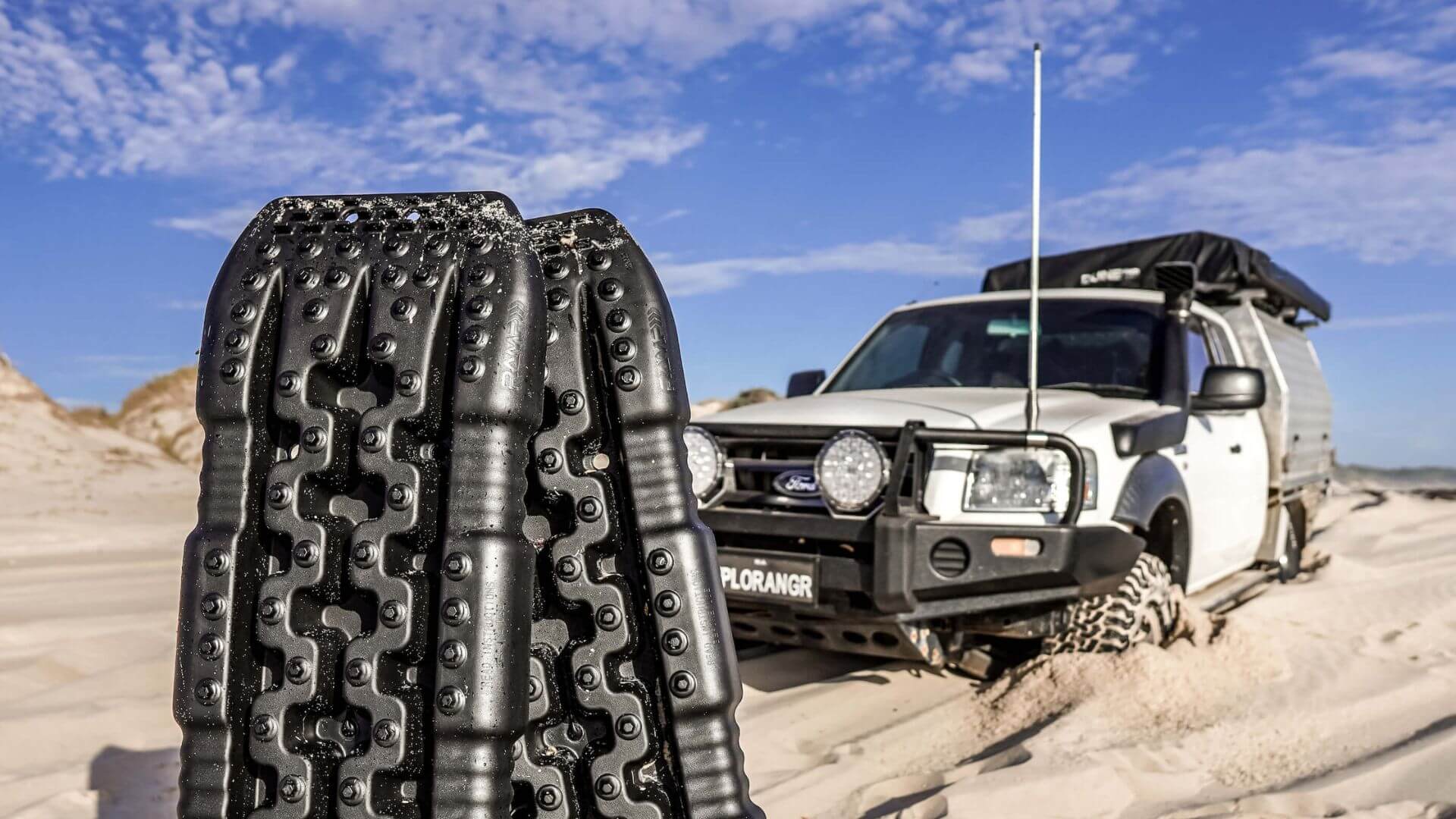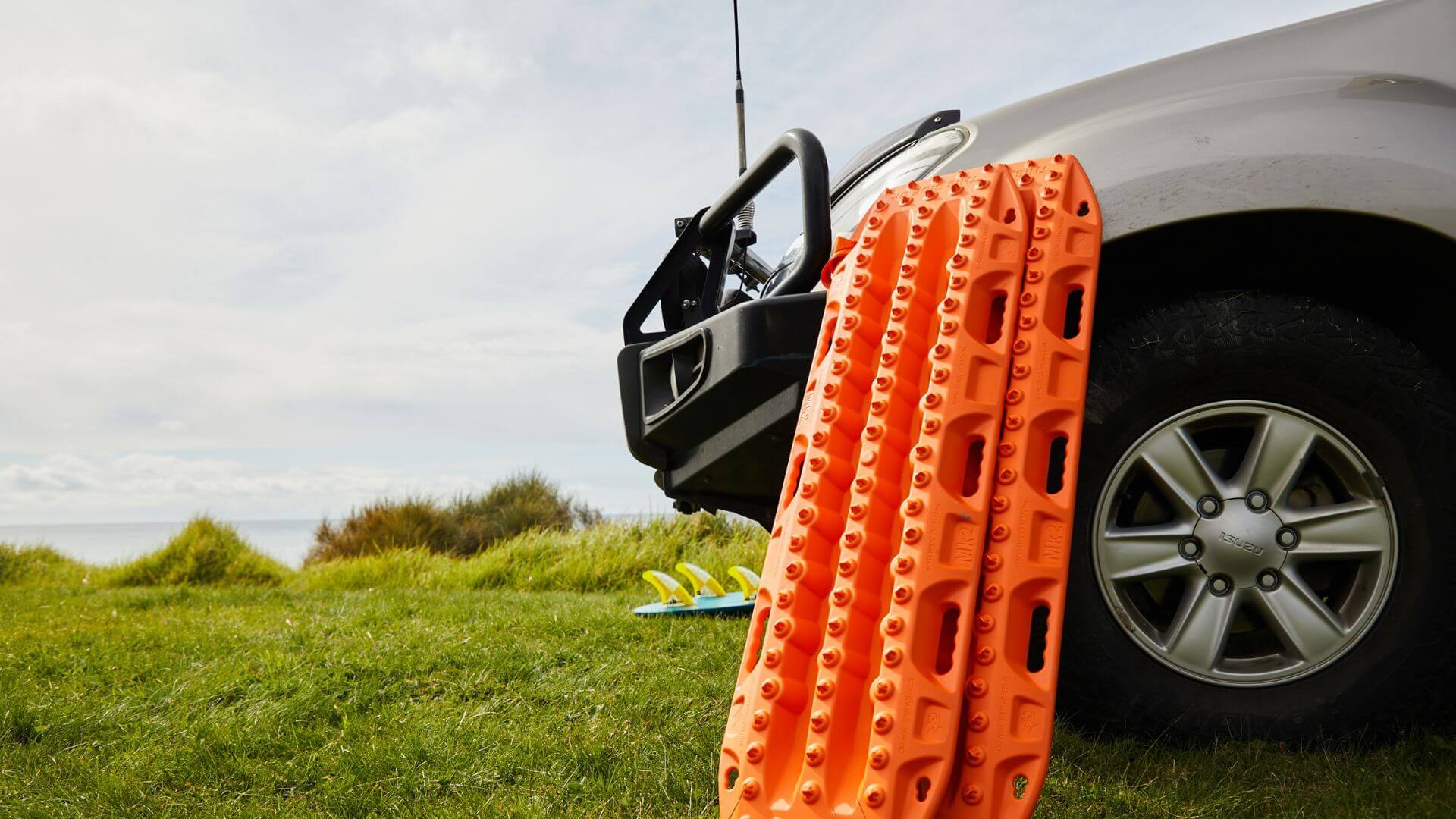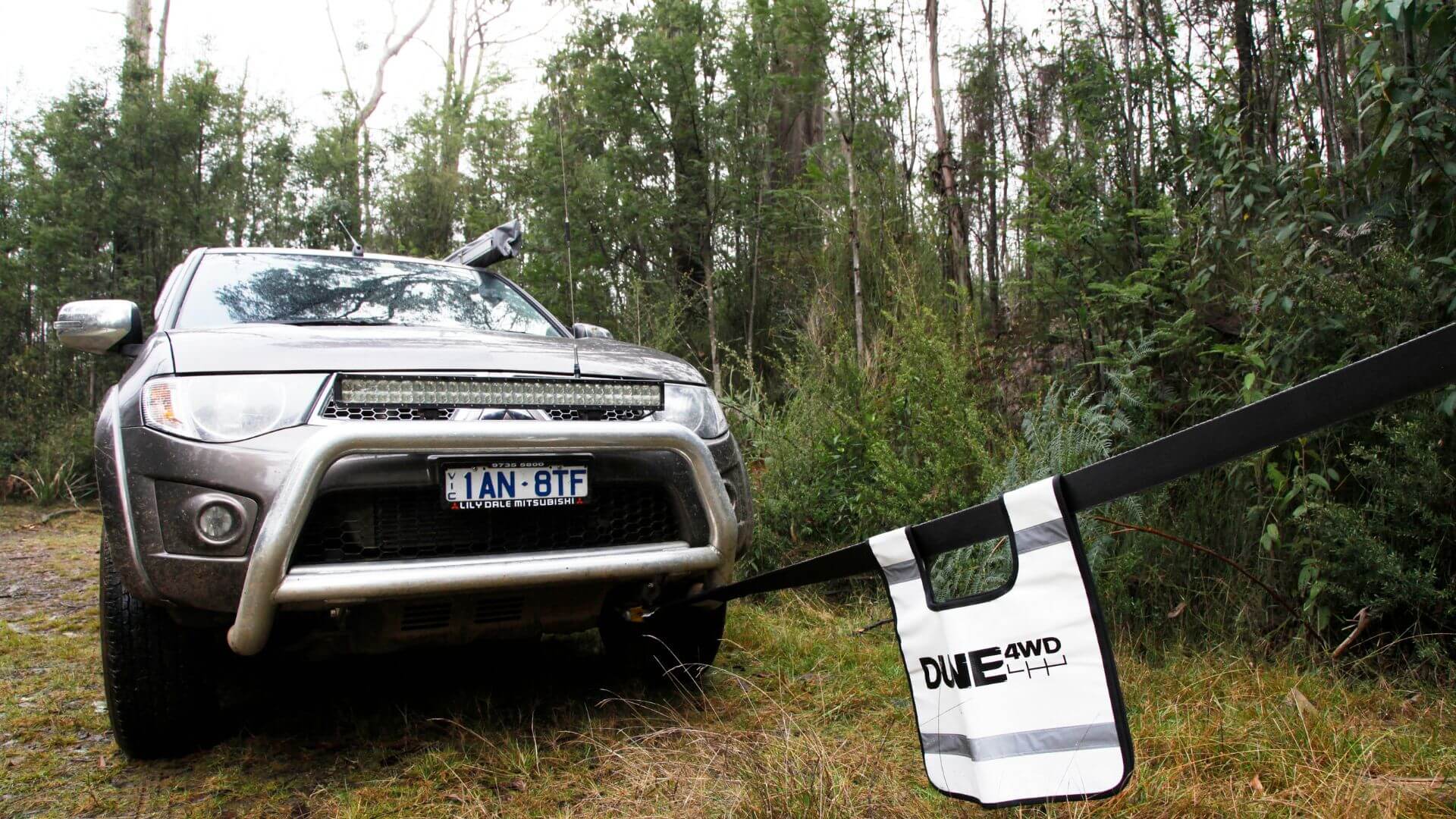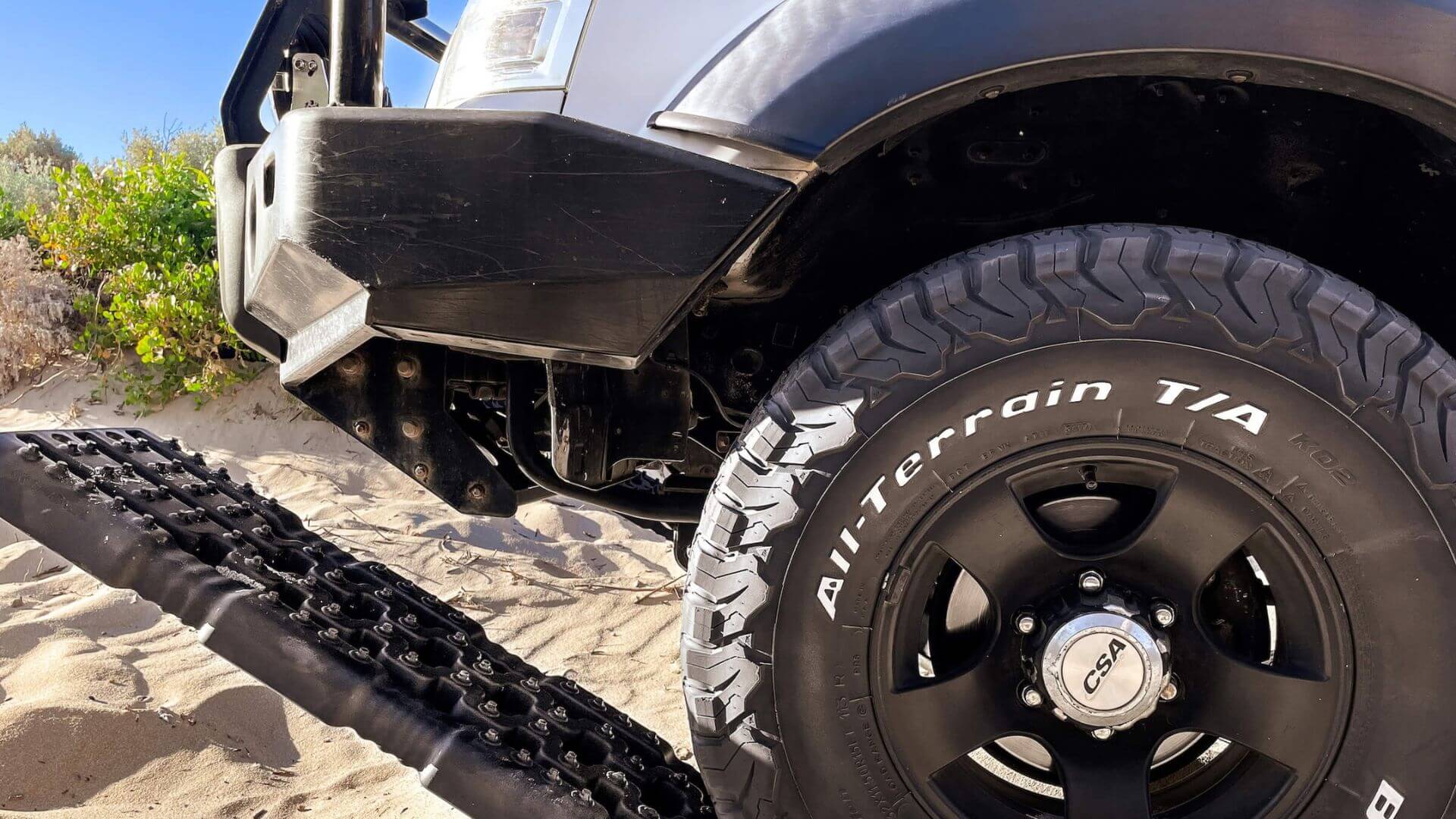| Your browser is not supported. | ||
|
Please browse our site using any of the following options:
| ||
4WD Recovery 101 - The Ultimate Guide to 4WD Recovery

Jumping behind the wheel of a 4WD is an amazing way to explore the roads, tracks and trails less travelled in Australia, and have some unrepeatable experiences in the process. But one of the hazards of true blue off-roading comes the increased likelihood of you and your family getting stuck.
Don't let that put you off!
Knowing how to recover your vehicle is an important part of getting the most out of your off-roading experience and ensuring everyone gets home safely and happy. It just goes with the territory of pushing your 4WD to the limit. First, here's a rundown of the equipment you'll need.
Quick Links:
- Essential 4WD Recovery Equipment For Every Adventurer
- Must Know 4WD Recovery Techniques
- General 4WD Recovery Safety Tips
- How to Perform A Recovery Board Extraction
- How To Perform A Snatch Strap Recovery
- How to Perform A Motorised Winch Recovery
Essential 4WD Recovery Equipment For Every Adventurer

When it comes to off-roading, there is some essential safety equipment that you must keep in your 4WD at all times to ensure that you can get out of any situation. These items are vital in any 4X4 recovery situation and should be treated as non-negotiables:
- Recovery boards
- Tyre pressure deflator
- Portable air compressor
- Lift jack
- Shovel
- Phone charger and GPS charger
- UHF communications
- Protective Gloves
Recovery boards
Recovery boards - often called recovery tracks - give your tyres the traction they need to get you out of sticky situations. They can also play a role in helping winch your 4WD, or someone else's, to safety.
Recommended recovery tracks:
Tyre pressure deflator and portable air compressor
Always pack a portable air compressor for increasing your tyre pressures as needed, as well as a tyre pressure deflator that includes a gauge. These are essentials that everyone on the road should carry.
Recommended deflators and compressors:
Lift Jacks
Make sure you have a jack weight-rated to safely lift your 4WD or caravan for tyre-changing, placing recovery tracks under, or for boosting wheels suspended in a crevasse. If you plan on doing a lot of sand driving, you might also want to consider a jack base specifically for use in sandy conditions.
Recommended Lift Jacks:
4WD Shovel
Although some recovery tracks double as shovels, having a purpose-designed shovel available can come in handy for digging sand, mud and snow from around tyres. An aluminium shovel is a great lightweight option, and specialised 4WD shovels can also be separated into pieces for easy storage and transport.
Recommended Shovels:
Phone/GPS charger
You may need to alert emergency services or other cars in your travelling group that you're stuck or unable to recover yourself. So, being low on battery is most definitely a situation you'll want to avoid. Make sure you have plenty of spare battery power with the appropriate phone/GPS chargers.
Recommended Chargers and Batteries:
- Cygnett ChargeUp Outback 20,000mAh Outdoor Solar Power Bank
- Dune 4WD 30 AMP 8 Stage DC to DC Charger
UHF Communications
You may have a mobile phone but, depending on the remoteness of your journey, the most reliable way to communicate when you're off the beaten track is a UHF/CB radio set up. They're an essential tool in performing a snatch strap recovery too, and well worth the investment.
Recommended UHF Radios:
- GME TX6160 5 Watt UHF CB Handheld Radio Pack
- Garmin inReach Mini 2 Compact Satellite Communicator With GPS
Personal Locator Beacons
Personal Locator Beacons (PLBs) are crucial in 4WD recovery due to their reliable emergency signalling, pinpointing your exact location via satellite. They ensure rapid response in remote areas with no phone reception, providing an essential lifeline during breakdowns or accidents. Compact and easy to use, PLBs provide peace of mind when it comes to 4WD recovery in remote areas.
Recommended PLB’s:
Protective gloves
It's a good idea to have some form of protective gloves to avoid possible injury while getting out of a sticky spot. A humble pair of gloves will protect your hands when getting down and dirty with your vehicle and equipment.
Recommended Gloves:
Must Know 4WD Recovery Techniques

Now, let's get down to business! There are three main types of recovery techniques: recovery board extraction, winch recovery and snatch strap recovery. Recovery boards and snatch strap recoveries are the best way out of trouble when you're bogged in mud, sand, snow and water. A winch can also be used to recover your 4X4 from the same kind of situations, but a motorised winch working together with your 4WD's engine is far more efficient at recovering your vehicle. The extra pulling power increases the success rate of recovering vehicles that have become stuck on rocks or uneven ground.
General 4WD Recovery Safety Tips
Whether it's a recovery board extraction, a winch or snatch strap recovery, there are some non-negotiable safety practices you should follow:
- Never use a tow ball as an anchor point for a snatch strap recovery. Towballs aren't designed to withstand the stress and pressure that dragging a 4WD out of trouble will put on them, especially with a snatch strap. There are far too many instances of people being killed or seriously injured when a towball has been sheared off its mounting.
- Always use rated recovery points on the front and rear of your 4WD. Consult your owner's manual to locate these recovery points and, if you're still unsure, contact your dealer. It's important not to confuse the tie-down points that are used in transporting your car from the factory to your dealership for recovery points - these points are nowhere near strong enough to handle the load and will damage your chassis or drivetrain if you try to use them to tow a bogged 4WD. If your 4X4 doesn't have rated recovery points fitted, you must get a front and rear after-market recovery solution fitted to your vehicle before heading out on an off-roading adventure.
- Always use rated recovery gear. If any of your recovery gear doesn't have a safe working limit - or your shackles, straps, tree trunk protectors, winches, jacks or anything else to get yourself out of trouble, or to help others, out of trouble doesn't have a safe working load limit clearly stamped or marked on them - then they're not safe to be used. If you bought your 4WD as a used vehicle, it might be worthwhile replacing the safety kits that came with the car with the latest rated equipment unless you can be absolutely sure about their integrity.
How to Perform A Recovery Board Extraction
Recovery boards - or recovery tracks - are the best solution in many instances when bogged in sand or mud.
Grab your recovery boards. Using your shovel, dig away the excess mud or sand (whichever is holding you in place). If there's a lot of mud in the tread of your tyres, clear some of that away as well. If you haven't already, let some of the air out of your tyres. In many cases, this will increase the ability of the tyres to grip the recovery boards enough to get you up onto solid ground.
When you've cleared everything away from the tyre, wedge the recovery boards under the front part of the wheels. The recovery boards should give you enough traction to move forward and pop your 4x4 on top of the terrain.
To get moving, engage your diff lock, select a low range gear, go easy on the throttle and gently move your vehicle forward onto solid ground.
How To Perform Perform A Snatch Strap Recovery
Although it's a highly effective recovery technique, performing a snatch strap recovery should be your last option when you or someone else's 4X4 is stuck. It's the most dangerous type of recovery to perform because there are so many things that can go wrong, and it has the potential to cause serious injury if there's an equipment failure or the recovery points on your 4WD fail to cope with the load stress.
A snatch strap is a reinforced and rated nylon cable strap with the capacity to stretch to approximately 30 percent of its original length, acting like an elastic band when activated. Connected to rated recovery points on the bogged 4X4, and connected to the recovery vehicle by a load-rated soft shackle, the strap stretches and then contracts as the recovery vehicle pulls. The kinetic energy generated in the contraction works to 'snatch' the bogged vehicle out of its predicament and move it back onto solid ground.
To get the full effect of the snatch strap, there needs to be a good amount of slack in the strap and no kinks (it should be nice and straight). A rated bow shackle or soft shackle is preferred over D-shackles when it comes to snatch straps. There are some horrible stories out there about the damage caused to 4WDs - and 4X4 drivers - by a snapped D-shackle!
Similar to a winch, place a cable dampener on your snatch strap. If there's an equipment failure, the dampener will minimise the chance of the cable causing damage.
Try getting about two to three metres of slack to allow the towing vehicle to gather enough momentum to generate the kinetic energy required to recover the stuck vehicle. Most inexperienced snatch strap users assume you need to drive like a bat out of hell to get the most out of the strap - but it's not the way to drive the recovery vehicle. When you do drive really fast, it puts a massive amount of pressure on the recovery points of both 4X4s and the strap itself. So, the chances of your strap breaking, or your recovery point failing, increases significantly. Both vehicles need to drive out nice and slowly. If you do need a little more pace, go a little bit quicker the next time.
In any recovery situation, communication is key - this is where your UHF/CB radio shows its worth. The driver of the bogged vehicle is able to let the recovery vehicle driver know that they're ready and, likewise, the recovery vehicle driver can let the driver of the bogged vehicle know that they're off. Then, both vehicles can adjust their acceleration to suit.
Additionally, both vehicles should be in low gear. As the driver of the lead vehicle takes off, the driver of the bogged vehicle assists by accelerating. As soon as the snatch strap puts them on to solid ground, they're able to drive themselves the rest of the way.
There are some important safety points to bear in mind when it comes to sensible use of snatch straps:
- When choosing one or a kit for your 4WD, always check it's rated to cope with the weight of your vehicle and whatever you're planning on towing - like a caravan, boat or camper trailer.
- Always use a cable dampener when performing a snatch strap recovery, and only use the correct Working Load Limit (WLL) rated recovery points on both vehicles.
- Make sure everyone is well clear of the vehicles. And the only people who should be in the vehicles when performing a snatch strap recovery are the drivers (no passengers).
How to Perform A Motorised Winch Recovery
Combining the safe working load of a motorised winch with the power of your 4X4's engine means there won't be too many situations you can't be recovered from. So, If you have the budget for one, adding a motorised winch to your 4WD is a smart move when planning on going well off the beaten track, trail or creek.
As well as your winch, you'll need a winch recovery kit. There are plenty of them on the market but the best value kits will include a winch extension strap, a cable dampener to put across your cable and a soft shackle in place of a D-shackle. Soft shackles are lighter and therefore a lot safer compared to metal shackles. And, don't be fooled by the name - soft shackles are as strong as D-shackles. You might not necessarily need them but a good winch recovery kit will also include snatch straps.
The most important accessory in a winch recovery kit is, arguably, a tree-trunk protector. Tied toward the base of a strong nearby tree, the tree-trunk protector will ensure you don't ringbark or permanently damage the tree but also provides you with a reliable anchor point.
To winch yourself out of a bog, place your tree-trunk protector around the base of a strong tree and connect it using your soft shackle. Unspool your winch line and drag it towards your tree, ensuring it's slack at the point of attachment. Attach the winch rope to the soft shackle with the hook facing upwards. Remember to always use protective gloves when dealing with winch lines.
At around the halfway point between your 4WD and the anchor point, place your cable dampener on the winch line. A cable dampener will take the energy out of the cable if there's an equipment failure, so it's a really great safety device.
With your winch controller connected, jump back in your vehicle. Just like when running a compressor to inflate your tyres, your winch can take a lot out of the battery, so you'll want to run your engine when you're winching out. It will also enable you to leverage your 4WD engine's torque to assist the winch and ensure you can back onto solid ground.
Start by bringing the winch line in, until you can see it tensioning. When it's taut, place your 4WD in first gear and provide some throttle to assist the winch to do its job. Try to match the speed of your winch motor to keep the tension in the line. When you reach solid ground, disengage the winch motor and continue to drive forward until there's no tension in the cable line. Don't drive over the winch dampener - you don't want it to get caught up in the winch as you retract the cable. Take all of the equipment off and place it back in your winch recovery kit.
When you're winding in the winch line, ensure there's some tension in the line and that it goes in evenly by feeding it across the barrel (and the same again when going back the other way). If you let the line bunch up, it will twist and won't work properly the next time you need to use it. As your line gets closer to the barrel, keep your fingers clear of the mechanism. As it locks in, the hook should be taut against the chassis and stored away securely.
There are some vital safety practices to observe when you're using a winch:
- Make sure there is no one else around. Keep your family and friends well clear from your 4X4 and its winch mechanism, as well as away from your anchor point.
- Never step over a taut winch line. If you have any equipment failure, standing over the line when it fails will cause all sorts of damage, even when using a cable dampener.
- When winching a vehicle out of trouble, don't switch your winch motor on and off. This will burn out the solenoids. When you're retracting your vehicle, keep the winch on and let your low range engine torque take some of the load. This will ensure your winch lasts longer.
- When you're winding in your winch rope at the end of the recovery, don't put your fingers anywhere near the spooling mechanism. And wind the line in evenly so it doesn't double up.
- Always service your winch and run it often. The more often you run it, the more often it's going to work for you. So, every now and then, place a fair bit of load on it, and then wind that rope in nice and evenly across the drum in both directions.
- Always wear safety gloves when using a winch. This will help you avoid painful rope burns on your hands.
Safely Recover Your 4WD and Challenge Yourself on the Track With Anaconda

It may seem a lot to take into account, but safe practices when 4WDing will ensure maximum fun, no matter what unexpected situations the Australian wilderness may throw at you. You'll be pleased you went to the extra effort when you're able to safely recover your vehicle if bogged, stuck on rocks or trapped in water. Shop all your 4WD essentials including 4WD recovery gear, towing gear, fuel containers and auto accessories online or in-store at Anaconda. Here's to happy off-roading!
Find more useful articles and tips on the Adventure Centre at Anaconda. Some articles you may like include: